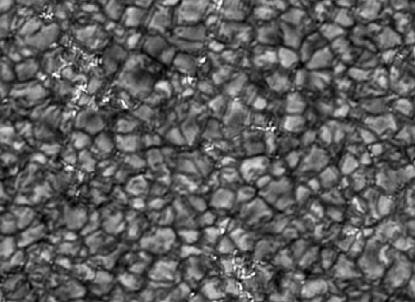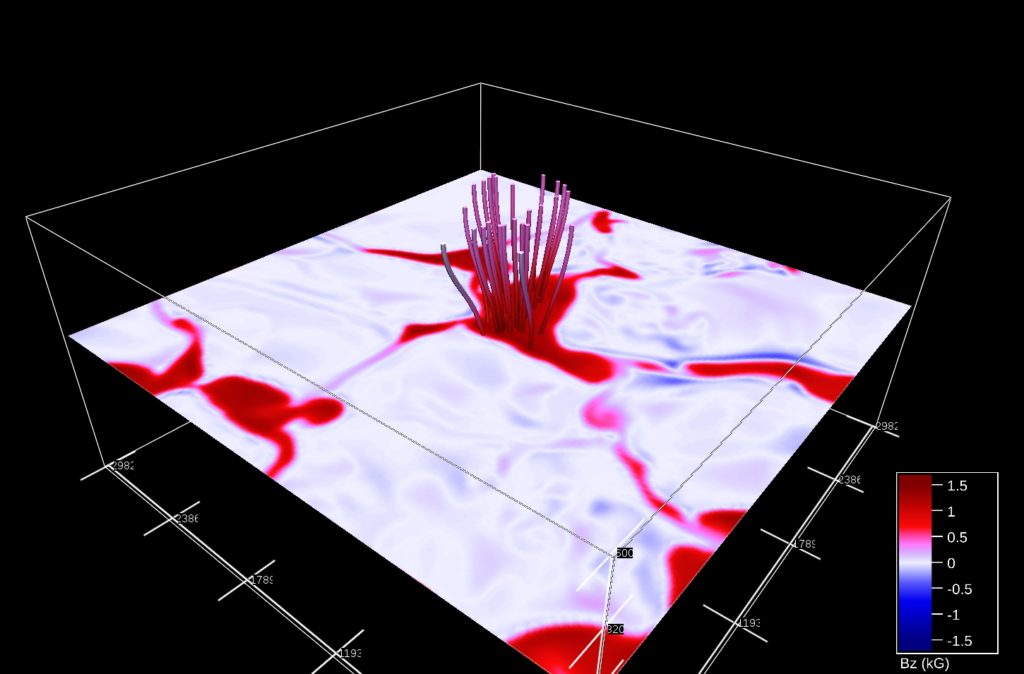
Late 2003 and early 2004 I was a third year BSc student. I was lucky enough to be taken to La Palma by my professor Rob Rutten, presumably to use the Dutch Open Telescope, a fancy looking half alien with a 45 cm reflective telescope on top, that makes some awesome images (and movies!) of the solar atmosphere. It turned out to be cloudy for two weeks (on the mountaintop, lovely weather on the rest of beautiful island, not too bad….), so my “project” became more of a literature research and playing with some old data than an observational one.

I started looking into “bright points” in “intergranular lanes”. The granules, see left, are the top of convection cells, pretty much the upper layer of the boiling sun. In the darker lanes in between the cooling gas falls back down to be heated and boiled up and again later. Inside these darker lanes you sometimes see very bright spots. These are places where bundles of magnetic field stick up through the surface. These contain some less gas, so you look deeper into the Sun where it is hotter, hence the brightness of these spots.
With different filters you can choose at which height in the solar atmosphere you look (more or less; I guess you understand I take few shortcuts in my explanation here…), so we can see how such regions look higher up and see what the gas and these magnetic bundles do. Looking at a bundle from the top isn’t necessarily very informative, but when you look near the limb of the sun, you are basically getting a side view of these things:

I spent about 3 months discussing with the solar physics group in Utrecht, which still existed back in the day, trying to figure out how these magnetic fluxtubes actually work. I wrote a (admittedly mediocre quality) Bachelor’s thesis about this work that ends with some speculations. I fondly remember how my supervisor did not like my magnetic field structure based interpretation and believed it was more related to effects of the temperature structure and corresponding effect on how the radiation travels through these bits of atmosphere.
I suddenly was drawn back to this topic two weeks ago, when I read the Dutch popular astronomy magazine Zenit. It was a special about Minnaert’s famous “Natuurkunde van ‘t vrije veld” and featured an an article by the designer of the DOT, Rob Hammerschlag, and talked about observations of the Sun, including these magnetic structures. I followed some links from the article and found myself browsing the professional solar physics literature from the past decade or so, on the look for the current verdict on these “straws” in the middle image above.

Obviously, the answer is slightly complicated and not as simple as mine (or my professor’s!) interpretation from 2004. While I was suggesting twisted magnetic field lines to be important, it turned out likely that the relevant phenomenon that is important in these straws are torsoidal waves through the tube (waves that you can make by grabbing it, and twisting like you twist the throttle of a motorcycle). Great fun to be taken back on a journey into the solar atmosphere, just by reading a simple popular article!